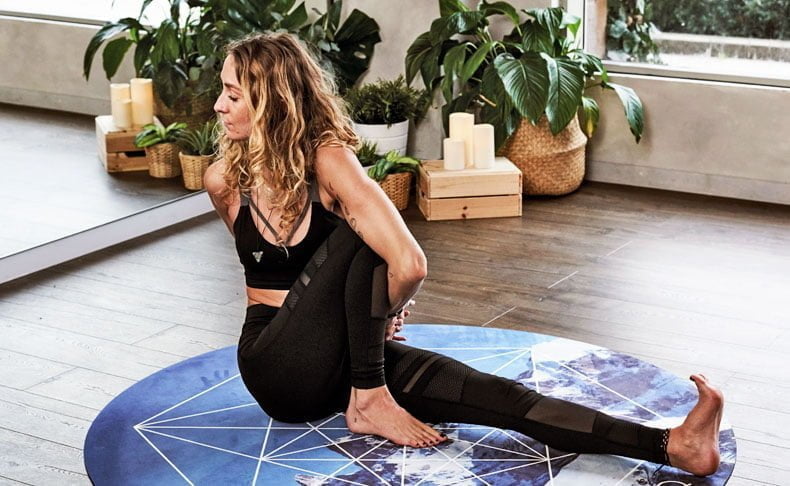What Is Kundalini Yoga

There are so many different forms of yoga out there that it’s difficult to decide which style is for you and when/where you should practice each different method. Here we’ll give you an overview of all things Kundalini Yoga so that you can understand what it is, why you should try it and what the benefits of practicing this style are.
Kundalini is a style of yoga practice that centres around pure/divine energy that is thought to be located at the base of the spine (the area also known as the base/root chakra). The belief is that we all hold this divine energy within our bodies but that it is not until it is activated and channelled upwards through our energy bodies, through the practice of Kundalini Yoga, that we are really able to engage and make the most of this pure, spiritual energy. The name Kundalini is derived from the Sanskrit word “kuṇḍalin” meaning “circular” but as a noun, it also refers to “a snake”. When you put these two words together, you begin to understand the concept of Kundalini energy representing a coiled snake at the bottom of our spines which we then release to rise up through the chakra system.
While both males and females can, of course, practice Kundalini, this style of yoga is often associated with the divine feminine.
History Of Kundalini Yoga
Kundalini was first introduced to the public in 1935 through the medium of the “Kundalini Yoga” book by Sri Swami Sivananda Saraswati. This book teaches the importance of combining Laya Yoga (the teaching of dissolution of self) with Hatha and Tantra practices in order to awaken your Kundanlini energy.
Later, in 1968 Kundalini was brought to America by Harbhajan Singh Khalsa who began teaching his own strain known as Kundalini Yoga as taught by Yogi Bhajan. This helped to popularise the practice, spanning from the United States and Europe to African, Australia and beyond!
What Is Involved In A Kundalini Practice?
Unlike sequence-based yoga like Bikram or Ashtanga, Kundalini practices can be quite different from one class to the next, depending on the group dynamic and the teacher. In general, Kundalini consists of a combination of other yogic practices such as Bhakti Yoga (devotion and chanting), Raja Yoga (meditation), Hatha Yoga (movement, breathwork and asana postures), Shakti Yoga (expressing power and energy) and Kriya Yoga (self-discipline, self-study and devotion to God) as well as some Tantric practices. It is this combination that makes Kundalini unique and which many practitioners find is the key to unlocking consciousness and building vitality.
Many Kundalini practices focus on sitting down, using breathwork, the application of bandhas (yogic locks) and physical activation of the spine to become conscious of, and then direct and control, the Kundalini energy flow. The practice also uses mantras such as Sat Nam “Truth is my identity” to focus the mind, taking you away from the unconscious chatter that is so prolific!
What Are The Benefits Of Kundalini Yoga?
As Kundalini helps to awaken the energy inside of us, the benefits of the practice are vast and varied and each person can experience different feelings and emotions. Depending on where you are on your spiritual path, you may experience feelings of peace and bliss, open channels to psychic encounters, increase compassion and empathy and even heighten your senses. Kundalini, when practiced regularly, can also work to slow down ageing, build strength, aid creativity and increase both your IQ and emotional intelligence.
In addition to helping to clear your mind and energy pathways, Kundalini Yoga is also good at helping to detoxify the body. Using repetitive movements, you can release toxins that are stagnant in the body, waking up the lymphatic system, boosting circulation and improving digestion.
When/Where Should I Practice Kundalini Yoga?
Many yoga studios and healing centres offer a wide range of yoga styles and as such, you should be able to find a Kundalini class near you. These are usually early morning classes as Kundalini helps to bring in prana (energy) for the rest of the day and your mind is less likely to be distracted first thing in the morning. There are, however, specific Kundalini techniques that aid in winding down and sleeping, so of course, these can be practiced at night. N.B. It is recommended that you don’t eat 2-3 hours before your practice so that your mind and body are light and free to let the energy flow.
If you don’t have a yoga studio nearby that offers Kundalini classes, you might want to join a Me Time Away retreat that provides Kundalini as part of the schedule so that you can learn the basic postures, breathing patterns and mantras before starting a personal practice at home.
So, there you have it, the basic of Kundalini Yoga! This should serve as an introduction to Kundalini Yoga and will hopefully have given you some inspiration to get out there and try it for yourself. There are no requirements or limitations to starting Kundalini Yoga so there really is no excuse not to give it a go. If you don’t like it after a few sessions, hey, don’t worry you might be better suited to Ashtanga, Vinyasa or Yin yoga instead or read about the latest yoga trends.
[……]
